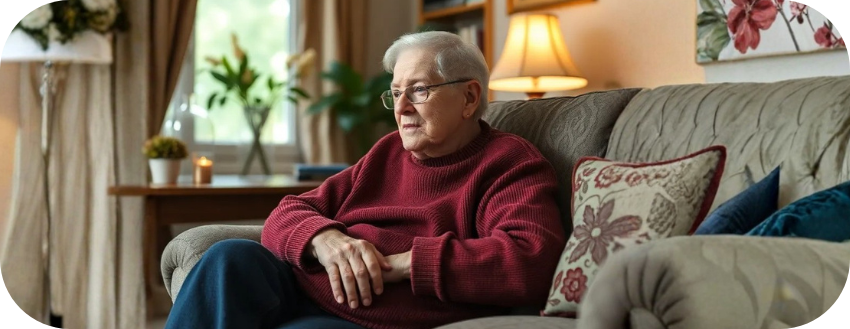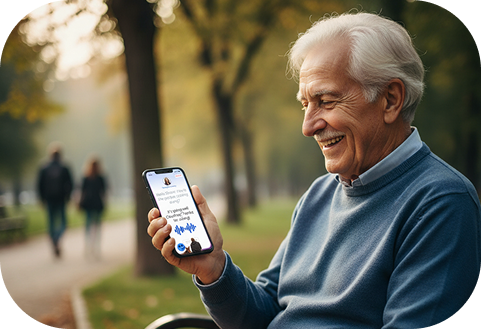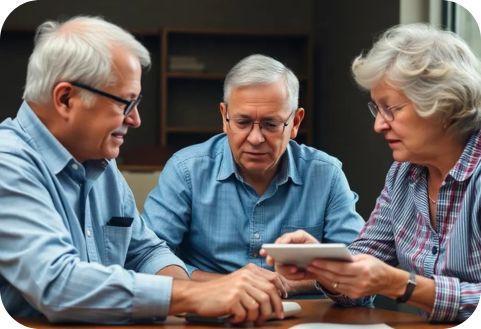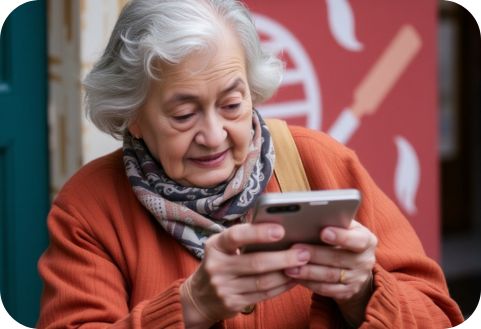Loneliness and Social Isolation in Seniors – Stay Connected
Growing older often brings wisdom, calm, and stories worth sharing but it can also bring profound feelings of loneliness and isolation.
Updated on: 05 Aug 2025

Growing older often brings wisdom, calm, and stories worth sharing but it can also bring profound feelings of loneliness and isolation. For many seniors, quiet afternoons without a visit or fading networks of friends leave the heart heavy and the mind restless. The urge to feel seen, heard, and connected remains deeply human but so too do the barriers that distance, health, mobility, or life changes can erect. This blog explores the emotional landscape of loneliness in later life and offer practical, tech-friendly strategies to stay connected, engage purposefully, and reclaim a sense of belonging.
When social bonds fade, the result isn’t just sadness it’s a ripple through mind, body and spirit. Research shows that feelings of loneliness and social isolation among older adults are strongly tied to risks of depression, cognitive decline, heart problems and even increased mortality (ScienceDirect.com). Social isolation (few interactions) and loneliness (feeling alone even amid people) are different yet often intertwined (BioMed Central). This means that simply being around people isn’t enough connection must be meaningful.
In our digital era, technology offers lifelines. Tools like video-calling, social platforms, interactive games, virtual communities and AI companions designed to bring comfort, engagement, and connectivity to seniors. These advanced AI-driven platforms confirm that technology interventions can strengthen social support and mitigate feelings of loneliness and isolation among older adults (OUP Academic).
But it’s not just about turning on a device it’s about designing the experience around trust, comfort, motivation and support. One review stressed the importance of matching technology to older adults’ values, confidence and ease of use (BioMed Central).

Technology, when used with empathy and accessibility, can become a lifeline for older adults struggling with isolation. The key is simplicity, consistency, and emotional relevance. Start by introducing easy-to-use communication tools such as video calling apps (Zoom, FaceTime, WhatsApp) that allow seniors to see and interact with family and friends in real time an essential emotional connector. Beyond video calls, modern AI companions like ElliQ, ReComune, Replika, and Hyodol are helping bridge the emotional gap by offering daily conversations, gentle reminders, and companionship for seniors living alone.
Encouraging seniors to engage in online hobby groups, like Senior Planet or AARP’s Virtual Classes, helps restore a sense of belonging and shared purpose. These digital communities promote social learning and emotional support, proven to improve cognitive and mental health outcomes (Seniorplanet.org). Pair technology with digital literacy training programs, available through community centers or public libraries, which empower seniors to feel confident using devices. Studies show that even minimal training significantly lowers loneliness scores in older adults (National Institutes of Health).
Finally, combine tech use with routine check-ins and scheduled virtual meetings, making connection part of daily life. When technology becomes a familiar friend rather than a foreign tool, it transforms isolation into opportunity helping seniors stay emotionally active, socially engaged, and mentally resilient.
Instead of a quick call, schedule a meaningful video chat with family or friends. Seeing each other’s expressions, sharing small moments this visual closeness bridges distance. Many older adults who adopt video-based communication report richer feelings of connection (OUP Academic).
Ask someone to send a simple tablet preloaded with apps and walk you through using it. Comfort with the tech matters.

Online story circles, exercise classes, book clubs or hobby groups give back the rhythm of community. The chance to speak, listen and respond to others brings energy. Consider digital platforms that cater to age-friendly design (large text, easy navigation).
Studies show these provide benefits, albeit not eliminating loneliness completely (SpringerLink).
Set gentle alarms or calendar alerts for daily or weekly connection goals: a phone call, photo-share, message to a friend. Technology like smart speakers or simple smartphones can help. These reminders make connection intentional, not accidental.
A sense of routine and expectation helps reduce that quiet desperation of “no one will reach out.”
Think beyond chat: shared virtual meals, collaborative photo albums, playing simple online games with peers, or using video-call tools to watch a show together. These shared experiences create connection anchors. Digital interventions training older adults in tablet or computer use have shown positive effects on loneliness and social isolation (journal.gerontechnology.org).
If learning new tech feels daunting, ask family, caregivers, library volunteers or community centers for help. Training someone, even in small steps, improves confidence and uptake. Barriers such as low tech skills, limited access, or physical restrictions were major hurdles in intervention studies (BioMed Central).
Ensure devices are ergonomic, settings increase font size, and shorten steps to initiate calls or messages.
Technology should enhance not replace human touch. A robot pet can offer comfort, but human interaction remains essential. One research note warns: while digital tools have value, they cannot fully substitute real-world relationships (geriatric.theclinics.com). Use tech as part of a broader connection plan: family visits, local club involvement, volunteering opportunities.

Feeling connected often flows from giving as much as receiving. Send photos of grandchildren, write digital notes, join an online mentoring chat. These acts build agency, purpose and belonging. Activity theory suggests staying socially active is key to healthy aging (National Institutes of Helth). Tech tools like email, messaging apps or simple voice-recorded greetings empower that giving-back feeling.
While technology provides meaningful ways to connect seniors with the world, there are still barriers that need compassion, patience, and support to overcome.
Many older adults hesitate to use devices due to fear of “breaking something” or sharing personal data online. This anxiety often discourages experimentation and learning. To minimize this, start with user-friendly interfaces, such as tablets with large icons or voice-controlled assistants, and offer patient, step-by-step guidance. A study by Seifert et al. (2020) found that positive emotional support during training greatly improves seniors’ digital confidence and adoption rates (ScienceDirect.com).
Limited income or internet availability can restrict older adults from using technology. Community initiatives like AARP’s Senior Planet and government-funded digital inclusion programs provide affordable or donated devices to bridge this gap. Accessibility is not a luxury it’s essential for digital connection.
Even with digital connection, some seniors report feeling emotionally distant. Real warmth often comes from blending digital and face-to-face interactions, like combining video calls with occasional visits. Research from SpringerLink (2024) confirms that technology reduces loneliness most effectively when paired with human connection and empathy (SpringerLink, 2024).
Digital solutions help, but loneliness is deeply emotional and often multi-layered. Continuous support from family, caregivers, and peers ensures technology becomes a tool for connection not a substitute for companionship.
To every senior reading this: you are not alone. Your voice matters. Your smile is welcome. Technology isn’t magic, but it’s a bridge a way to stretch your hand out and find a response, a laugh, a memory shared.Reach for your phone, open that tablet, join that video call. Ask for help when tech feels unfamiliar. Let someone know you want to try. Then schedule regular time to connect not just when you remember, but because you deserve connection. Stay curious. Stay brave. The distance can shrink, the silence can soften, and your heart can open to new rhythms of belonging.

In today’s hyperconnected world, many older adults still experience an invisible silence loneliness. Despite the abundance of digital tools, emotional isolation continues to rise, especially among seniors.
Updated on: 24 Jul 2025